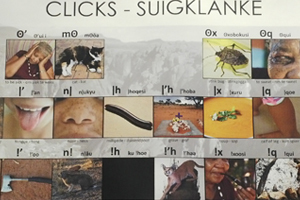Threatened African languages in the spotlight
09 May 2014 | Story by Newsroom
South Africans may be familiar with the country's eleven official languages, but there are a host of others still spoken here and by our closest neighbours.
Some of these languages were in the spotlight as part of an exhibition dubbed Orthography Development for non-Bantu Click Languages, which illuminated the Beattie Building foyer on 8 and 9 May. The exhibition was based on research by the Centre for African Language Diversity (CALDi) and was held as part of university's annual Africa Month celebrations.
Visitors were treated to a graphic and phonetic alphabet of Nǁng, a language that as of April 2014 was spoken by only five elderly women in the Northern Cape Khomani community. Nǁng is the last surviving !Ui language, which together with the Taa branch forms the Tuu language family. The extinct !Ui languages are believed to have been spoken in most parts of present-day South Africa.
A history of Ts'ixadam (literally 'Ts'ixa-tongue'), a largely written language that is still spoken by only 200 people in northern Botswana as of April 2011 was also on display. A community language workshop took place that month in Mababe, the only remaining Ts'ixa village, at which community members agreed on an orthography for their Khoeid (Central Khoisan) language.
The high prevalence of HIV in Mababe threatens the survival of the small community, while boarding schools threaten the survival of the Ts'ixa language, with many young Ts'ixa more comfortable speaking Setswana and English, the languages in which they are educated.
Phonetically-explained alphabets of numerous other languages were also on display, as was a map of the modern Khoeid, Tuu and Kx'a families and the Hadza and Sandawe languages. The map is based on 20 years of research by the author and director of CALDi, Matthias Brezinger.
Story and image by Yusuf Omar.
 This work is licensed under a Creative Commons Attribution-NoDerivatives 4.0 International License.
This work is licensed under a Creative Commons Attribution-NoDerivatives 4.0 International License.
Please view the republishing articles page for more information.










